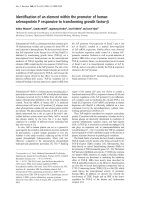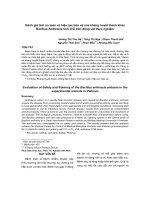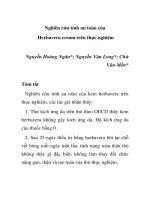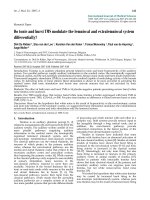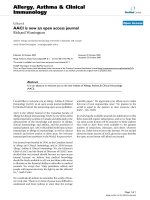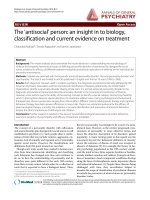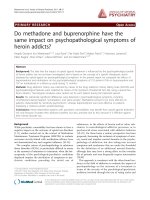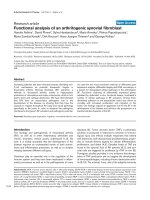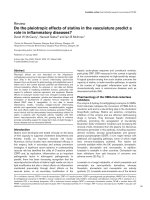Báo cáo y học: "Do bronchodilators have an effect on bronchiolitis" pptx
Bạn đang xem bản rút gọn của tài liệu. Xem và tải ngay bản đầy đủ của tài liệu tại đây (35.14 KB, 3 trang )
RSV = respiratory syncytial virus; t
PTEF
/t
E
= exhaled time to reach peak expiratory flow as a fraction of total expiratory time; V
maxFRC
= maximal flow at
functional residual capacity produced by forced expiration as a result of a rapid chest compression; V
PTEF
/V
E
= tidal volume exhaled at peak tidal
expiratory flow as a fraction of total tidal volume.
Available online />In this issue of Critical Care, Totapally and colleagues [1]
evaluate the effect of albuterol on tidal breathing loops of 20
infants with respiratory syncytial virus (RSV) bronchiolitis. They
found that the wheeze score and the pulmonary function tests
were not significantly affected by albuterol. This is the latest of
12 randomised controlled trials in 12 years [2–12], involving
843 infants, that evaluated the effect of bronchodilators on
bronchiolitis. After so many trials, have we resolved whether
bronchodilators have a role in the management of bronchiolitis,
and have pulmonary function measurements been helpful?
Salbutamol, albuterol and ipratropium bromide
Of the 12 most recent randomised controlled trials published
in English, evaluating the effect of salbutamol or albuterol on
bronchiolitis, nine (75%) showed that bronchodilators had no
effect. In three of these studies, some difference had been
observed [3,11,12], yet it resulted in only a small transient
improvement in the acute clinical score and had no effect on
hospital admission rates or duration of stay in hospital. In one
of these three studies [11], ex-premature infants who might
have had some mild underlying chronic lung disease, which
might have resulted in the response to bronchodilators, were
not excluded. Several studies reported an increase in heart
rate [12] or a decrease in oxygen saturation [3] after
salbutamol or albuterol.
The effect of ipratropium bromide (either alone or in
combination with salbutamol or albuterol) on bronchiolitis has
been evaluated in four recent randomised controlled trials
[5,6,9,13] and none has shown any significant effect.
Nebulised adrenaline
In contrast, there have been five published randomised
controlled trials in the last 10 years, involving 225 infants,
evaluating the effect of nebulised adrenaline (epinephrine) on
bronchiolitis [7,14–17]. All five (100%) have shown
significant clinical improvement in infants with bronchiolitis,
with decreases in oxygen requirement, respiratory rate,
wheeze and retractions. Menon [14] showed lower hospital
admission rates, and Bertrand et al. [15] found that the group
Commentary
Do bronchodilators have an effect on bronchiolitis?
Margrid Schindler
Consultant, Paediatric Intensive Care Unit, Great Ormond Street Hospital for Children, London, UK
Correspondence: Margrid Schindler,
Published online: 11 March 2002 Critical Care 2002, 6:111-112
© 2002 BioMed Central Ltd (Print ISSN 1364-8535; Online ISSN 1466-609X)
Abstract
Over the past 12 years there have been 12 randomised control trials, involving 843 infants, evaluating
the effect of salbutamol or albuterol on bronchiolitis. Of these, nine (75%) showed that bronchodilators
had no effect. In three studies a small transient improvement in the acute clinical score was seen.
Ipratropium bromide had no significant effect. There have been five recent randomised trials involving
225 infants, evaluating the effect of nebulised adrenaline (epinephrine) on bronchiolitis. All five (100%)
have shown significant clinical improvement, with reductions in oxygen requirement, respiratory rate
and wheeze after nebulised adrenaline. Two showed lower hospital admission rates and earlier
discharge with adrenaline. A significant improvement in pulmonary resistance was observed after
nebulised adrenaline but not after salbutamol or albuterol. Currently there is no compelling evidence
that bronchodilators have a role in the routine management of infants with bronchiolitis. There is better
evidence for the use of nebulised adrenaline.
Keywords albuterol, bronchiolitis, nebulised adrenaline, pulmonary function tests, salbutamol
Critical Care April 2002 Vol 6 No 2 Schindler
given nebulised adrenaline were discharged from hospital
earlier. A significant improvement in pulmonary resistance
was also observed [16]. The incidence of side effects is no
more frequent with nebulised adrenaline than with
salbutamol. The 90-minute heart rate was often significantly
lower in the adrenaline group, and although pallor was noted
more frequently it was transient and of no known clinical
significance [14].
Pathophysiology
These results suggest that mucosal swelling and mucous
plugging make a greater contribution to the increased airway
resistance observed in bronchiolitis than constriction of
bronchial smooth muscle. Barr et al. [18] found a beneficial
effect of inhaled adrenaline in an infant with RSV bronchiolitis
who was also receiving β-adrenergic receptor blockade with
propranolol. This indicates that it was most probably the α-
adrenergic stimulation that was improving airway obstruction
by inducing arteriolar vasoconstriction in the airway mucosa
and thus reducing bronchial mucosal thickness.
Pulmonary function tests
Of the 12 randomised studies evaluating the effect of
bronchodilators on bronchiolitis, only in those by Totapally et
al. [1] and Sly et al. [10] were any pulmonary function
measurements made. Totapally used tidal breathing flow-
volume loops to assess the effect of albuterol on infants with
bronchiolitis, and they found no significant change. Two main
calculations were made: the exhaled time to reach peak
expiratory flow as a fraction of total expiratory time (t
PTEF
/t
E
)
and the tidal volume exhaled at peak tidal expiratory flow as a
fraction of total tidal volume (V
PTEF
/V
E
).
The time needed to reach peak tidal expiratory flow is highly
influenced by the activity of the laryngeal abductors and
adductors, abdominal and intercostal expiratory muscles,
post-inspiratory activity of the diaphragm and intercostal
muscles, and vagal nerve tone [19,20]. Changes in these
muscle activities could cause significant alterations in t
PTEF
/t
E
independently of changes in the resistance and compliance
of airways and lung. Thus t
PTEF
/t
E
is an insensitive measure of
airway function in infants and children in comparison with
V
maxFRC
(maximal flow at functional residual capacity
produced by forced expiration as a result of a rapid chest
compression) and other more invasive techniques [19].
Sly et al. [10] performed a randomised trial of salbutamol in
infants with bronchiolitis and measured V
maxFRC
and found no
significant change.
Sanchez [16] also conducted pulmonary function tests in a
crossover trial comparing salbutamol with racemic
adrenaline. As in other studies, administering salbutamol
resulted in no change, whereas adrenaline significantly
decreased pulmonary resistance. Sanchez et al. used a more
invasive technique, measuring transpulmonary pressures
(with an oesophageal catheter), flow and volume to
determine pulmonary resistance by a least-mean-square
technique. They excluded breaths in which the leak was
greater than 10%, the correlation coefficient was less than
0.95 or the tidal volume was less than 0.5 ml/kg, to eliminate
the analysis of shallow breaths and artefacts.
Leaks around the mask or around an uncuffed endotracheal
tube can cause major errors in the pulmonary function
measurements and lead to gross overestimation of compliance
and resistance [21]. The inspired and expired volumes need to
be within 10% of each other to allow an accurate analysis.
Totapally et al. did not specify the minimum acceptable leak in
their study. Ideally, absolute lung volume should also be
measured to help in the interpretation of resistance changes;
however, this is invasive and difficult to perform.
Conclusion
Although Totapally and colleagues should be commended for
performing pulmonary function measurements to assess
further the effect of albuterol on infants with bronchiolitis, the
pulmonary function results need to be interpreted with a
degree of caution. However, in view of the general lack of
effect of bronchodilators in bronchiolitis in other studies, I do
not think that any significant effect of albuterol on pulmonary
function was missed in this study. It also highlights the urgent
need for a simple non-invasive test that can measure lung
function in infants more accurately.
In summary, there is no compelling evidence that
bronchodilators have a role in the routine management of
infants with bronchiolitis. There is better evidence for the use
of nebulised adrenaline, which results in a reduction of the
airway mucosal oedema, leading to symptomatic
improvement, improved pulmonary function and shorter
hospital admissions.
Competing interests
None declared.
References
1. Totapally BR, Demerici C, Zureikat G, Nolan B: Tidal breathing
flow-volume (TBFV) loops in bronchiolitis in infancy: the effect
of albuterol [ISRCTN47364493]. Crit Care 2002, 6:160-165.
2. Dobson JV, Stephens-Groff SM, McMahon SR, Stemmler MM,
Brallier SL, Bay C: The use of albuterol in hospitalized infants
with bronchiolitis. Pediatrics 1998, 101:361-368.
3. Can D, Inan G, Yendur G, Oral R, Gunay I: Salbutamol or mist in
acute bronchiolitis. Acta Paediatr Jpn 1998, 40:252-255.
4. Cengizlier R, Saraclar Y, Adalioglu G, Tuncer A: Effect of oral
and inhaled salbutamol in infants with bronchiolitis. Acta Pae-
diatr Jpn 1997, 39:61-63.
5. Goh A, Chay OM, Foo AL, Ong EK: Efficiency of bronchodila-
tors in the treatment of bronchiolitis. Singapore Med J 1997,
38:326-328.
6. Chowdhury D, al Howasi M, Khalil M, al Frayh AS, Chowdhury S,
Ramia S: The role of bronchodilators in the management of
bronchiolitis: a clinical trial. Ann Trop Paediatr 1995, 15:77-84.
7. Reijonen T, Korppi M, Pitkakangas S, Tenhola S, Remes K: The
clinical efficiency of nebulized racemic epinephrine and
albuterol in acute bronchiolitis. Arch Pediatr Adolesc Med
1995, 149:686-692.
8. Gadomski AM, Lichenstein R, Horton L, King J, Keane V, Permutt
T: Efficiency of albuterol in the management of bronchiolitis.
Pediatrics 1994, 93:907-912.
9. Wang EE, Milner R, Allen U, Maj H: Bronchodilators for the
treatment of mild bronchiolitis: a factorial randomized trial.
Arch Dis Childh 1992, 67:289-293.
10. Sly PD, Lanteri CJ, Raven JM: Do wheezy infants recovering
from bronchiolitis respond to inhaled salbutamol? Pediatr Pul-
monol 1991, 10:36-39.
11. Klassen TP, Rowe PC, Sutcliffe T, Ropp LJ, McDowell IW, Li MM:
Randomized trial of salbutamol in acute bronchiolitis. J Pediatr
1991, 118:807-811.
12. Schuh S, Canny G, Reisman J, Kerem E, Bentur L, Petric M,
Levison H: Nebulized albuterol in acute bronchiolitis. J Pediatr
1990, 117:633-637.
13. Schuh S, Johnson D, Canny G, Reisman J, Shields M, Kovesi T,
Kerem E, Bentur L, Levison H, Jaffe D: Efficacy of adding nebu-
lized ipratropium bromide to nebulized albuterol therapy in
acute bronchiolitis. Pediatrics 1992, 90:920-923.
14. Menon K, Sutcliffe T, Klassen TP: A randomized trial comparing
the efficacy of epinephrine with salbutamol in the treatment
of acute bronchiolitis. J Pediatr 1995, 126:1004-1007.
15. Bertrand P, Aranibar H, Castro E, Sanchez I: Efficiency of nebu-
lized epinephrine versus salbutamol in hospitalized infants
with bronchiolitis. Pediatr Pulmonol 2001, 31:284-288.
16. Sanchez I, De Koster J, Powell RE, Wolstein R, Chernick V: Effect
of racemic epinephrine and salbutamol on clinical score and
pulmonary mechanics in infants with bronchiolitis. J Pediatr
1993, 122:145-151.
17. Kristjansson S, Loprup-Carlsen KC, Wennergren G, Strannegard
IL, Carlsen KH: Nebulised racemic adrenaline in the treatment
of acute bronchiolitis in infants and toddlers. Arch Dis Childh
1993, 69:650-654.
18. Barr FE, Patel NR, Newth CJ: The pharmacologic mechanism
by which inhaled epinephrine reduces airway obstruction in
respiratory syncytial virus-associated bronchiolitis. J Pediatr
2000, 136:699-700.
19. Mikkilineni S, England S: On tidal expiratory flow measure-
ments in infants. Pediatr Pulmonol 1994, 18:71-72.
20. van der Ent CK, van der Grinten CP, Meessen NE, Luijendijk SC,
Mulder PG, Bogaard JM: Time to peak tidal expiratory flow and
neuromuscular control of expiration. Eur Resp J 1998, 12:646-
652.
21. Main E, Castle R, Stocks J, James I, Hatch D: The influence of
endotracheal tube leak on the assessment of respiratory
function in ventilated children. Intens Care Med 2001, 27:
1788-1797.
Available online />
